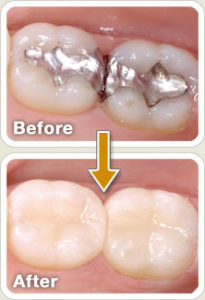How Are White Fillings Used?
White fillings are most often used to fill cavities or replace silver amalgam fillings, but they can also be used to change the color of a tooth or reshape a disfigured tooth. If there is a gap in between teeth, white composite resin can be used to fill the gap.
Composite resin is strong, so it provides support for the teeth in addition to its pleasant appearance. This can help to prevent fragile teeth from breaking or sustaining other types of damage. This resin can also be used to create veneers.
Placing White Fillings
If amalgam is being replaced by composite resin, the amalgam will be removed using high-powered suction. The tooth or teeth on which the composite resin must stick will be demineralized using a special gel.
A bonding agent will be applied, and the composite will then be applied in layers with a special light being used to harden each layer. Finally, the filling will be shaped and polished to prevent wear and optimize the bite.
Weighing the Pros and Cons

White fillings support the teeth and protect the mouth from temperature changes, but may wear out quickly in larger cavities. But in small to medium cavities, they typically hold up just as well as other types of fillings.
If you need a cavity filled or would like to replace your amalgam filling with a white filling, speak to one of our team members today to get started.
Frequently Asked Questions
What is the benefits of white fillings?
Does getting a filling hurt?
Do fillings require any special maintenance or care?
We've Got You Covered
Insurance We Accept
Don't see your insurance listed? No worries! If you have a PPO plan, you can use it here.
Contact us
to verify your coverage
Our Doctors
Meet our Family of Dentists
Dr. Standish has been serving Clay County patients at Eagle Harbor Dental for over 40 years. His daughters Dr. Kelly & Dr. Erin joined the practice and they’ve been creating beautiful smiles as a family ever since. With extensive educations and memberships, our dentists are the best that Fleming Island has to offer.





Ready to get started?
Book your appointment
Give us a call
(904) 269-6558
or send us a message using the form below








